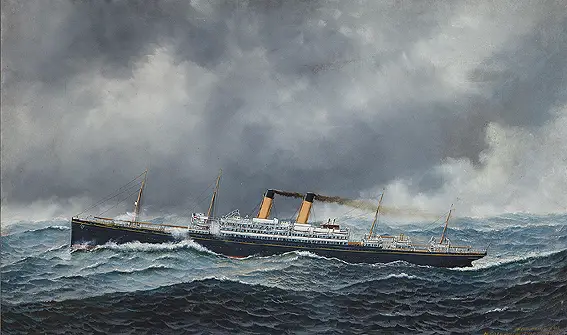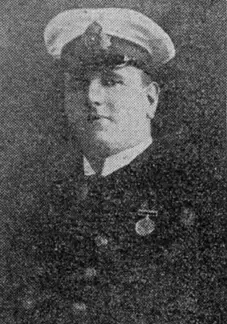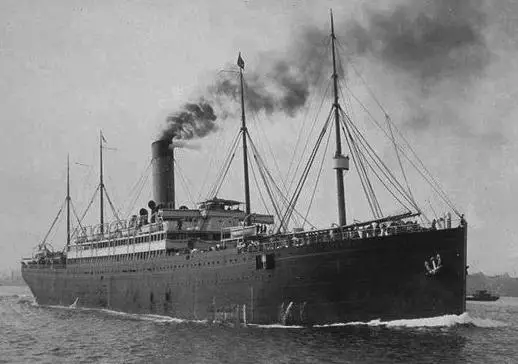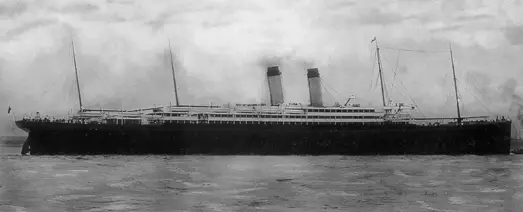Side Menu:
Chief Purser Hugh McElroy
- 1903 SS Cedric, Republic and Baltic

A dramatic painting of the R.M.S. Cedric at sea, 1906 by Antonio Jacobson (1850 - 1921). (Click image to enlarge)
By March 1903, McElroy was working aboard the SS Cedric - the second of a quartet of White Star Line ships over 20,000 tons, dubbed the Big Four, and the largest vessel in the world at the time of her entering service. She was 700 feet long, a beam of 74 feet, with 5 decks and a top speed of 17 knots. More important to McElroy was a capacity for 1223 passengers in his care. Of these 365 were in first class and 160 in second.
Her maiden voyage was on the 11th of February 1903 between Liverpool and New York City with McElroy in place as the Purser. His later 11th of April 1903 "Particulars of Engagement" lists his previous ship as the "Majestic" and the "Date and Place of signing this Agreement" as "9/2/1903" in Liverpool - two days prior to the maiden voyage. At the time his residence is also listed as "St George Hotel, Liverpool" and a wage of £15 per month.

Hugh McElroy is listed on the Cedric's 11th of March 1903 "Particulars of Engagement". (Click image to enlarge)
The captain for this maiden voyage was none other than Herbert Haddock, who would go on to be master of Titanic. Also on this journey, in the role of Second Officer, was Henry Wilde, who would later become the Olympic's and Titanic's Chief Officer.
LINER CEDRIC IN PORT
The largest steamship ever constructed slowly made her way, last evening
between 6 and 8 o'clock, up New York Bay and the North River to the White
Star piers at the foot of Banks Street. The huge vessel was the new
transatlantic liner Cedric, a sister of the Celtic of the same fleet, but
ninety-six tons larger…. Her commander is Capt. H. J. Haddock, C. B., R. N. R., formerly of the
Britannic, Germanic and Celtic. The chief officer is Lieut. Alexander
Hambleton, R. N. R., and the chief engineer J. W. Alexander, who for the
last two years had been chief engineer on the Britannic, which has been
doing service as a Government transport. The purser is H. McElroy.
The New York Times
Saturday 21st February 1903

McElroy in his Purser's uniform in
an undated photograph
(Click to enlarge)
McElroy was also quoted by a newspaper about the maiden voyage. In an article in the Pittston Gazette dated 21st Feb 1903 detailing the completion of the Cedric's maiden voyage "all agreed that she met the test well…There were gales nearly every day and seas which boarded the shop from time to time over the bow." McElroy is subsequently quoted as referencing the evidence of the steadiness of the vessel by stating that the racks were out only once, and then only on one of the side tables "You would never know you were on a ship" he declared with pride. (Pittston Gazette, Pittston, Pennsylvania dated 21 Feb 1903)
There are three confirmed "Particulars of Engagement" that list McElroy as the purser - the 11th of March 1903, 11th of April 1903 and 31st of July 1903. The indication of a monthly engagement aligns with the known voyages of the Cedric, which took place from Liverpool to New York once a month (http://www.norwayheritage.com/p_ship.asp?sh=cedri)
During April 1903, when the Cedric arrived in New York on the 18th of April, McElroy's parrot, Baden-Powell was referenced by a May 1903 New York Times article detailing how McElroy acquired the bird and how it perched on McElroy's shoulder:
When the Cedric arrived at New York on her last trip Baden-Powell was not on deck when the big liner was berthed. Neither was his guardian. When found he was perched on McElrov's shoulder, the officer being busy in his office getting his papers 'ready to be turned over to the proper officials. An acquaintance of McEIroy's knocked at the door.
"Keep out. No lobsters wanted", was what the knocker on the outside heard from within.
"Shut. up Baden! Come in. It's all right," answered McElroy, and the friend opened the door. " McElroy greeted his friend warmly, while Baden-Powell, with a look of disdain on his peaked countenance, eyed him critically.
"Bum looker: don't cut much ice." piped the parrot.
(The New York Times, 4 May 1903).
1904 Republic and Sickness

RMS Republic (image: titanic-whitestarships.com)
McElroy then joined White Star's latest acquisition - the RMS Republic in 1904. Originally owned by the Dominion Line, under the name the Columbus, the White Star line bought her and renamed the ship the Republic initially for a service between Liverpool and Boston, but then used the ship to inaugurate the White Star's Mediterranean–New York service. White Star intended this route for two purposes: first, they sought to establish a market for cruising opportunities for wealthy American passengers, as her spacious and luxurious accommodations in first and second class attracted scores of wealthy vacationers, thus earning her the nickname "The Millionaires' Ship".
Hence, starting in 1904 a crossing from Boston to the Mediterranean via Gibraltar, making calls at Sao Miguel in the Azores, followed by the Italian ports of Naples and Genoa, and ending at Alexandria, a voyage which often took up to three weeks to complete one-way. According to an article in the Boston Globe it was during this voyage that McElroy was taken ill: "Owing to sickness purser McElroy was obliged to leave the ship at Alexandria, and Mr J.A. Shepherd, formely in the Afric, of the Australian service, was called from Liverpool to join the ship at Naples, which he did, coming the day before the Republic sailed." (The Boston Globe, 11 Feb 1904)
1904 Baltic Maiden Voyage and Captain Smith

The RMS Baltic, the largest vessel afloat in 1904. (Click to enlarge)
A few months later, in June 1904, McElroy is next mentioned aboard the Baltic, once again as part of a maiden voyage of a large ship. The Baltic was one of what was dubbed The Big Four (the other three being RMS Celtic, Cedric, and Adriatic) she was launched on 21 November 1903 by Harland and Wolff at Belfast and sailed from Liverpool on her maiden voyage to New York on 29 June 1904 At 23,876 gross tons, more than twice that of the Majestic, she was the world's largest ship until 1905.
Notably, McElroy joined the ship as purser with Captain Edward Smith in command. In a glowing article about the maiden voyage published in the New York Times of 9th July 1904, it is noted that the "lines on which the Baltic is built give her the characteristic look of the Cedric and Celtic, the two other largest ships of the White Star Line, but she exceed both of these by about 3,000 tons…. The new stemship has accommodation for about 3000 passengers bdesides her crew of 350" (The New York Times, 9 Jul 1904). There were 906 passengers on this journey, 209 in first class, 142 in second class and 555 in steerage. J.P. Morgan is also described as being aboard the ship, picked up by his private yacht in New York, the Corsair. "The officers of the Baltic are Thomas Kidwell, formerly of the Celtic, chief officer; W.E.Graham, surgeon; H. McElroy, purser, and H.Wovenden, chief steward." (The New York Times, 9 Jul 1904)
_2_small.jpg)
Captain Smith posing with passengers aboard the Baltic in 1905 (Photograph Joseph Marshall). (Click to enlarge)
1904 Baltic charity
Later that year McElroy was still listed as aboard the Baltic and according to a Democrat and Chronicle (Rochester, New York) article published on the 26th November 1904, he was involved in a very generous charitable act on behalf of a steerage passenger who had lost her life's savings aboard the ship on Wednesday the 23rd of November 1904.
One of the steerage passengers on the steam Baltic, which arrived today, was Mrs.Maria Kring, who would have been classed a pauper and sent back with her helpless brood of nine small children but of the generosity of the wealthier passengers in the cabin. On Wednesday Mrs Kring notified the purser that she had lost 1,500 kroners, equivalent to $325, which she had tied in a handkerchief concealed in her waist. She searched the steerage deck but could not find the money, and her plight was pitiable. Purser McElroy started a collection to replace the lost sum and contributions poured in. In half an hour the full amount had been collected and turned over to the weeping woman. (Democrat and Chronicle, 26th November 1904)